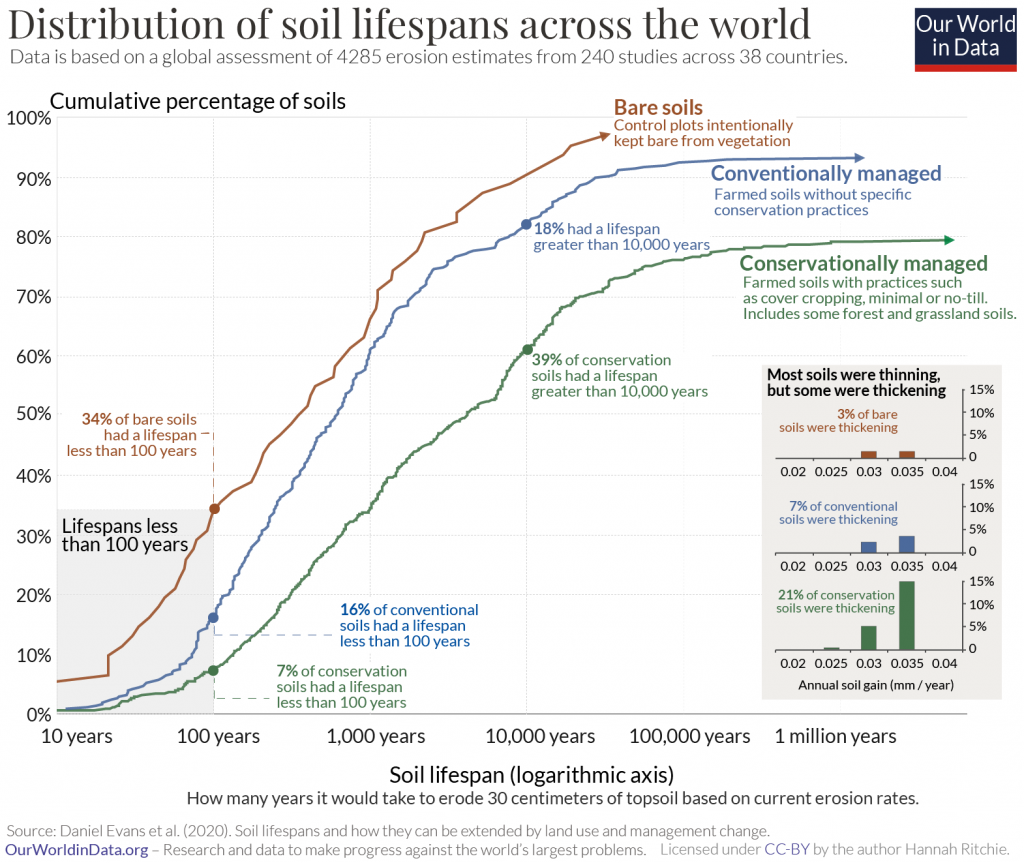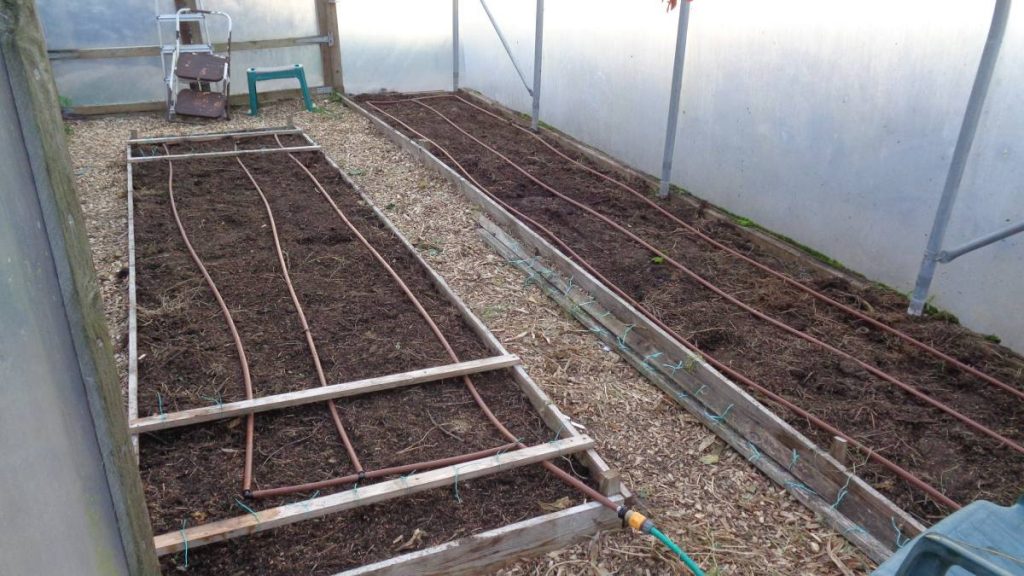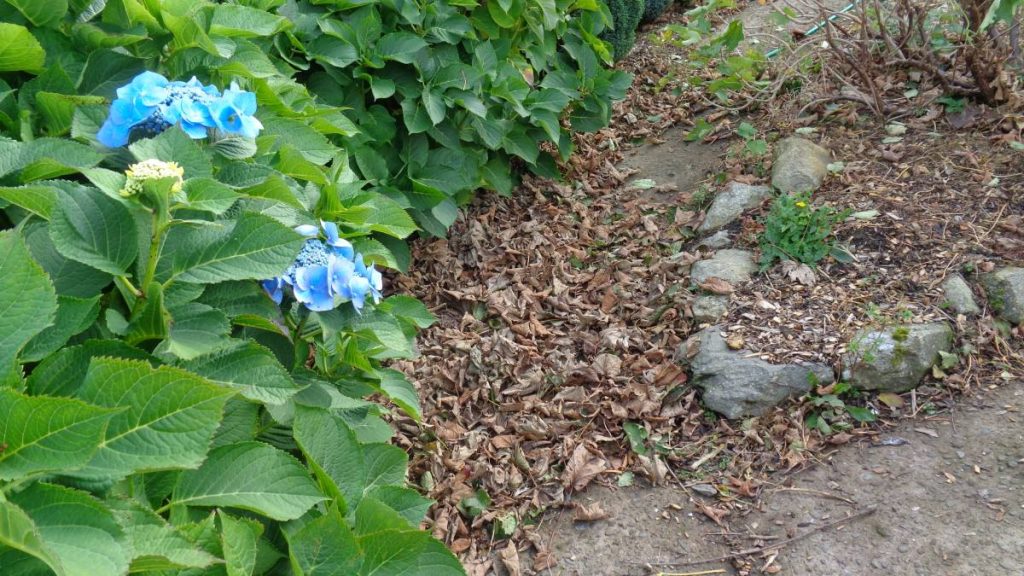Polytunnel growing is pretty intensive so the soil becomes nutrient deficient, especially the centre bed which gets worked the hardest with sweetcorn. Started by removing the top few inches of soil from the centre bed which went on to the plot outside. The side bed isn’t so full so didn’t remove any soil.
The soil wasn’t particularly compacted so I just opened it up with the fork. Push the fork in, rock it back and forth then move back six inches and repeat. Replace the removed soil with compost, levelled it and job done.
I’m a bit concerned that I didn’t see many worms when the soil was opened up. Implies a lack of organic matter in the soil which I hope the compost will sort out.
Autumn Leaves
The recent storms and strong winds are stripping the autumn leaves from the trees very quickly. Paths covered which is another job. I’ve a mulching leaf vacuum / blower but I’m waiting for them to dry out as wet leaves just clog up the machine.
Mushrooms
- Mushrooms popping up above the woodchip mulch under the fruit bushes.
- Smaller mushrooms in the field forming a chain
- About 15cm across – got a few of these mushrooms popping up.
Mushrooms are a good indicator of carbon in the soil. The fungal life cycle and requirements is totally different to the plants although they work closely with the plant world to the benefit of both. Read up on mycorrhizal fungi if you’re interested.
I’m happy to see lots of mushrooms on our land this year, more than ever before. Improved management of the pasture is showing returns. The organic matter and sequestered carbon increasing. In the heatwaves this year we saw evidence of improved drought resilience because of this controlled grazing.
The woodchip mulched areas under the fruit bushes and the paths have their own mushrooms popping up. Are they edible? I don’t know and Val wasn’t keen on trying them out and letting me know!
Soil Depletion
Following on from my previous post regarding food shortages, I thought it might be good to share something positive. You may have seen headlines that there are only 60 or 100 harvests left in our depleted soils so prepare to starve.
This seems to have been started with a book by Philip Lymbery called Sixty Harvests Left which then become a fact in the eyes of the green lobby. In my research into threats to our food security I found that the premise we only have 60 harvests before the soil is all used up is bunkum. To be clear, it’s scare mongering nonsense.
Some soils are badly managed, depleted and thinning but Our World in Data aggregated 240 studies from 38 countries looking at 4,285 erosion estimates. As you can see from the chart below, some 16% of our soil globally has an estimated lifespan of less than 100 years.
Our World in Data says
More than 90% of conventionally managed soils had a ‘lifespan’ greater than 60 years. The median was 491 years for thinning soils. Half had a lifespan greater than 1,000 years, and 18% exceeded 10,000 years.
I’m not worried at all about the soils that are degrading. It’s a complicated subject I’ve looked at in depth and whilst it sounds alarming the fact is that soil degradation can be reversed. Techniques like planting crops and green manures that pull minerals from sub-soil, fix nitrogen and improve humus levels have been proven effective in the real world. Not just on a small scale but also on large, conventionally farmed spreads.
Throwing in controlled grazing systems – aka mob grazing – further improves pasture resulting in increased depth of topsoil and fertility. It also produces better absorption and retention of extreme rain events along with improved drought resistance.
 Desertification
Desertification
However, halting and reversing soil degredation becomes progressively harder the worse it becomes. In hot climates we’re seeing desertification. Once the soil reaches the position of not supporting much apart from sparse scrub grazing, local climatic effects kick in and desertification increases as local rainfall decreases.
The result is the unfolding famine disaster we see in the horn of Africa. Reversing desertification is possible – but hugely difficult. Some of the work of Australian permaculturist Geoff Lawton in Jordan with his Greening the Desert Project is awe inspiring. He’s not the only one – John D. Liu, Allan Savory and many others are repairing the ecological damage.
Farming Economics
I’m afraid a lot of the problems come down to money. Economics are the driver for farming – hence the exploitative nature of many farms. Crops and profits today ignoring tomorrow. Not all farmers, but too many. It’s very understandable and forgivable for subsistence farmers on the edge but the destruction of the Amazon rain forest in the pursuit of agri-business profit is a crime against humanity and the planet. They’re drawing on the shared capital of the planet for their own benefit.
Summary
Soil degradation and depletion is a problem that has been exaggerated by a green media who find click-bait titles instead of fact-checking and research. Given the will, restoring and regenerating the land is possible. How to do it is well understood and proven.









I’m a bit thick when it comes these things . My fix was to add manure and rotted down compost every year, also fish blood and bone and bone organic fertilizer
Thank you for this. I’d heard about this and I do my bit in allotment and garden with horse manure, my own compost and leaf mould. It’s good to see that it’s not true by and large and all is not lost, but more needs to be done to support farmers both here and in the developing world with the best techniques.
As ever – a reminder to those using social media to check sources. Always check sources!
Gardeners, by virtue of our accepted label, all have an interest in the environment to varying degrees. Having joined this newsletter last week, I am pleased to see articles (e.g. above), that have been properly researched. These need to make their way into the mainstream as a rebuttal to spurious shouting from the green mafia who have a flawed/skewed grip on facts.
Martin – I’ve learned over the last decade not to trust any single source of information. There are serious problems that should be addressed without people more interested in click-bait than truth opening their mouth.
I’m afraid that social media isn’t the only source of misinformation – this 60 harvests left was pushed hard by the Guardian when the book came out. Sloppy, poor journalism IMHO. But it fitted with how they think things should be.
I find that the small farmers tend to care and look after the soil much more than the very large ones whos only interest is to make as much money as possible in the shortest time, as they can easily dump everything and move on to new fertile land. It all comes down to greed and the “me me me!” attitude.